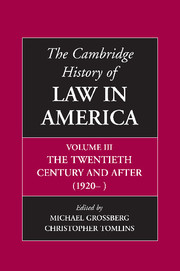Book contents
- Frontmatter
- 1 Law and the State, 1920–2000: Institutional Growth and Structural Change
- 2 Legal Theory And Legal Education, 1920–2000
- 3 The American Legal Profession, 1870–2000
- 4 The Courts, Federalism, and The Federal Constitution, 1920–2000
- 5 The Litigation Revolution
- 6 Criminal Justice in the United States
- 7 Law and Medicine
- 8 The Great Depression and the New Deal
- 9 Labor’s Welfare State: Defining Workers, Constructing Citizens
- 10 Poverty law and income Support: From the Progressive Era to the War on Welfare
- 11 The Rights Revolution in the Twentieth Century
- 12 Race and Rights
- 13 Heterosexuality as a Legal Regime
- 14 Law and the Environment
- 15 Agriculture and the State, 1789–2000
- 16 Law and Economic Change During the Short Twentieth Century
- 17 The Corporate Economy: Ideologies of Regulation and Antitrust, 1920–2000
- 18 Law and Commercial Popular Culture in the Twentieth-Century United States
- 19 Making Law, Making War, Making America
- 20 Law, Lawyers, and Empire
- Bibliographic Essays
- Notes on Contributors
- Index
- References
14 - Law and the Environment
Published online by Cambridge University Press: 28 November 2008
- Frontmatter
- 1 Law and the State, 1920–2000: Institutional Growth and Structural Change
- 2 Legal Theory And Legal Education, 1920–2000
- 3 The American Legal Profession, 1870–2000
- 4 The Courts, Federalism, and The Federal Constitution, 1920–2000
- 5 The Litigation Revolution
- 6 Criminal Justice in the United States
- 7 Law and Medicine
- 8 The Great Depression and the New Deal
- 9 Labor’s Welfare State: Defining Workers, Constructing Citizens
- 10 Poverty law and income Support: From the Progressive Era to the War on Welfare
- 11 The Rights Revolution in the Twentieth Century
- 12 Race and Rights
- 13 Heterosexuality as a Legal Regime
- 14 Law and the Environment
- 15 Agriculture and the State, 1789–2000
- 16 Law and Economic Change During the Short Twentieth Century
- 17 The Corporate Economy: Ideologies of Regulation and Antitrust, 1920–2000
- 18 Law and Commercial Popular Culture in the Twentieth-Century United States
- 19 Making Law, Making War, Making America
- 20 Law, Lawyers, and Empire
- Bibliographic Essays
- Notes on Contributors
- Index
- References
Summary
At first glance, “environmental law” might seem, from its name, a phenomenon of the late twentieth century, growing out of the 1960s environmental movement and taking off with the National Environmental Policy Act of 1969. In fact, environmental law cannot be understood apart from the long-established debates and tensions that define the traditions of American law as a whole: individual rights and the extent of state power, the authority of law and its means of implementation. Long before the mid-twentieth century, American law was fully engaged with such matters as, for example, the private use of common resources, such as wildlife and rivers; private activity that injured public health and welfare, such as the emission of industrial wastes; and the municipal assumption of administrative power to build networked sanitary infrastructure. Courts had accepted science-based rationales to authorize law that limited private rights. Governments had engaged in interstate responses to environmental problems that crossed jurisdictional boundaries.
Two essential categories of environmental law and litigation, nuisance and natural resources, are ancient and capacious: they have occupied courts, legislatures, and other governmental authority for centuries. To resolve problems that, today, we call “environmental,” Anglo-Americans have continuously developed or recognized new kinds of nuisances – from the wastes of medieval “noxious trades” to the invisible and odorless ozone created by twenty-first-century motor vehicle engines. In like manner, they have vastly broadened the category of natural resources, extending it far beyond substantial objects like fish to, for example, the stratospheric ozone layer, observable only by experts using esoteric instruments and conservable only by many nations acting in collaboration.
- Type
- Chapter
- Information
- The Cambridge History of Law in America , pp. 472 - 521Publisher: Cambridge University PressPrint publication year: 2008
References
- 3
- Cited by

